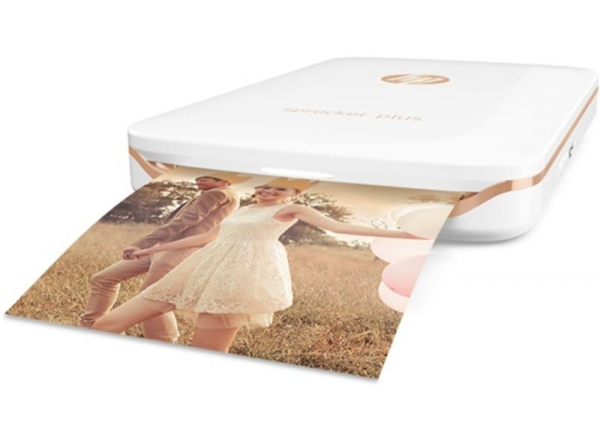HP
HP Sprocket Plus: a portable photo printer that scores
Aprox. 159€
See specificationsLast year, HP entered the Zink technology mobile printing market with its Sprocket. A convincing product overall, this year available in a "Plus" version for printing larger photos. The opportunity, too, to correct the mistakes of his little sister's youth?
Positive points
Improved print quality ...
Printer always easily transportable.
Ease of use.
Interesting autonomy.
Very resistant self-adhesive backing paper.
Bad points
... but which remains perfectible.
Application of a chick hair in possibilities.
The printer tends to heat up quickly.
Our review
Ergonomics
If the Sprocket "tout court" has appeared in recent months in a new color (red), the Sprocket Plus is only entitled to the two basic colors of the range: white with gold piping and logo, and black with silver piping and logo. You should know that the Sprocket "Plus" is logically slightly larger, not by much that said: it measures 89 x 142 x 18 mm, against 75 x 116 x 23 mm for the first model. It thus remains a perfectly nomadic product which will easily find its place in any bag, even a coat pocket since it is less thick.
Apart from that, the two printers are otherwise very similar in appearance. We find on the Sprocket Plus the very simple approach of the first product: a single power button located on the edge, a micro-USB port for charging and an LED that changes state depending on use of the printer.
Loading sheets of Zink paper is always child's play. Simply slide the printer cover back to access the slot provided. A small diagram shows in which direction to insert its refill of paper, if possible with the small cardboard barcode which is useful for the calibration. Each refill offers 10 views, and each impression takes an average of 60 seconds. It is 20 s more than with the classic Sprocket, but it remains a reasonable printing time.
Advantage of Zink technology, the printer is energy efficient and it is possible to make sixty prints on a single charge - full recharge requires a little less than 2 hours with a 2 A charger. pair the Sprocket Plus with your smartphone for the first time. The connection is made exclusively via Bluetooth, version 4.0 of the protocol being supported. Once this pairing has been carried out, the printer is very quickly operational after switching on.
To start printing, you must use the HP Sprocket app (Android and iOS). We were eager to dive back into this application to see if HP had taken care to improve it over the updates and do not hide it, we are a little disappointed on this point. The essentials are still there and the application is fully functional, but online storage services such as Dropbox are still not supported and the integrated retouching options still seem to us to be too impractical and limited. Fortunately, it is always possible to personalize your photos with one of the many editing applications that exist on the market, knowing that Instagram, Facebook and Google services are still basic integrated.
We have selected for you the best photo applications for smartphones dedicated to shooting, retouching, sharing and ...
However, all the photos in the "film roll" are immediately available for printing, while a bug sometimes forced us to wait a long time for this to be the case during our test of the first Sprocket. Likewise, we no longer found ourselves launching a print twice because of the slowness of the software. On these two specific points, there is therefore an improvement. On the other hand, if you print on the chain 3 or 4 shots, the message "Cooling down" always appears, the Sprocket Plus also needing to cool very frequently.
Image quality
In terms of image quality, we did not expect a miracle from the Sprocket Plus, whose photographic rendering is highly dependent on the Zink technology chosen by HP. Without cartridge or ink ribbons, this technology which uses ink pigments directly integrated into the paper is ideal for mobile printers, but has the defect of not producing a very detailed or faithful photo rendering.
The images produced by the Sprocket Plus, in 5.8 x 8.7 cm format (against 5 x 7.6 cm for the classic Sprocket) still show a fairly marked colorimetric drift, the average delta E measured with the probe s establishing at 10.7. This remains high (remember that the delta E accounts for the color fidelity and that the lower it is, the closer the measured color is to the reference color, the human eye no longer being able to perceive a difference below of 3). There is however a clear improvement compared to the results of the first Sprocket on this point. The average delta E was certainly barely higher (11.4 at the time), but the overall homogeneity is much better: here, we do not see colors whose rendering has completely changed, the strong dominant magenta which veiled the photos printed with the Sprocket disappeared, and it shows immediately (see comparison of prints above).
Despite using slightly larger sheets, the print resolution remains at 313 x 400 dpi. Although this is still sufficient with regard to the size of the printed photos, this partly explains the lack of detail and sharpness observed as soon as one begins to look at the pictures very closely. The oversaturation problems noted with the Sprocket are no longer to be deplored, but the lack of contrast in certain prints remains fairly obvious. So sometimes you should not hesitate to exaggerate the contrasts in retouching before launching an impression.
Conclusion
There's no denying that the HP Sprocket Plus is a better portable photo printer than its little sister, the Sprocket. More expensive, it shoots photos with slightly improved quality, in a slightly larger format, which is not to displease us.
Specifications

